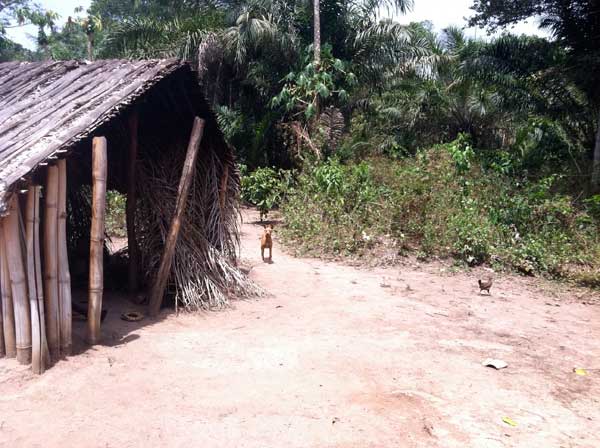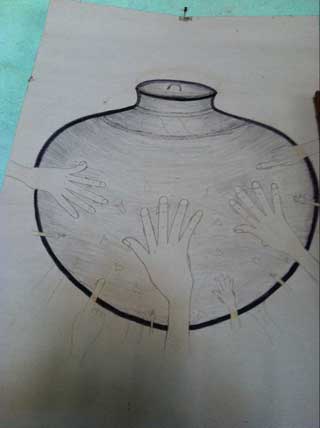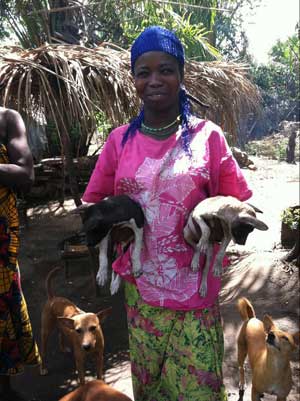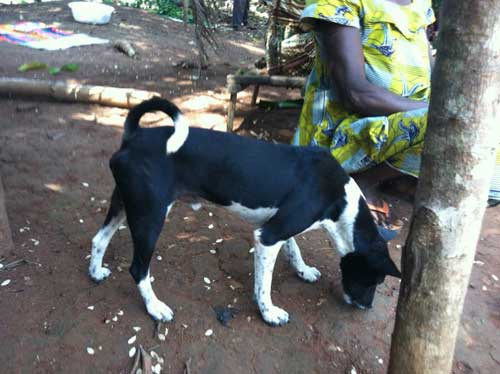Page 10
Africa/ by Katie Campbell, with photos by Katie Campbell
Taji Basenjis
West Seattle, WA ~ USA

This is one of my favorite photos from the trip. I think it captures the true essence of what a native Congolese Basenji is all about.
Africa
The word alone stimulates the imagination. It’s a powerful word to Americans. In a very general sense, I think that most of us consider Africa as one of the most populous continents of the world, having been plagued by a barrage of diseases for decades, and yet more recently – stunningly high degrees of political unrest. Visually, when Americans think of Africa, our minds reference photos of exotic cats, elephants, and zoo resident creatures…and on a more dismal note: starving children. Within the Basenji community, however, there is an additional element of wonder and awe, as it is the indigenous home to our beloved breed. Recently I had the great opportunity to travel to Uganda and then Congo to marry my imagination of Africa with my own reality.
As most of The Fancy is aware, we started with a very small Basenji gene pool in the western world – proliferated upon -- but not expanded for decades. The study of animal husbandry proves that small gene pools are dangerous on a number of levels. Meanwhile, technology has advanced and modern breeders now have access to a barrage of various health and genetic tests which most responsible breeders take advantage of in determining the state of their stock. With this information, many well-intentioned breeders eliminate “flawed” candidates from their breeding programs in their effort to eradicate various diseases. But on the other hand, this gallant effort further restricts the breadth of this abnormally small gene pool that leads to other inherent dangers.
I was fascinated by the reports from the last Avongara import trip that there were concerns about the next trip perhaps being the last. With the alleged rampant deforestation (thus concern of increased access between areas), and the advancement of society, many have feared that cross-breeding is compromising the “purity” of the native Basenji. I inquired with those who were on the last trip and before I knew it, I was invited to join them on the next trip.
Our group consisted of: Jon Curby of MO (his fourth trip), Michael Work of NY (his third trip), Fritz Clark of NH, Carrie Lewis of VT, Ethel Blair and Bev Reid of Australia, and me from Seattle. Little did I know at the time that it would take nearly two years for the climate, political unrest and our personal schedules to line up before we could book our trip. In the end I chose to extend my time in Africa on the front end of the trip by touring Uganda including big game safaris through Queen Elizabeth National Park, mountain-trekking with gorillas in the Bwindi Impenetrable Forest, and canoeing upon Lake Bunyoni…but for this article I’m going to focus on my time in Congo, more specifically in the Democratic Republic of Congo (DRC).
The area that we stayed is Dungu (DOONG-goo) which is a village in the Haut-Uele Province of the DRC. It’s in the upper northeast region of the country, not too far from Sudan, south of the Garamba National Park, near the point of confluence of the Uele and Kibali rivers. The climate there is tropical, though not as lush as one might expect. The terrain there is considered wooded savannah. As a native Seattlite, I considered it humid and dusty. This dust – which is everywhere - is red in color; It comes from the clay earth there; It ranges in texture from a powder to a grit; It gets into your shoes clothes and is almost impossible to launder out (I left almost all of my clothes there at the mission); And it sticks to your skin and hair like a magnet.
Few homes have walls. Most houses are more like a thatched roof functioning as an umbrella on wood stilts. Walls impede air circulation so they aren’t really practical. Having electricity in your home is considered a luxury that few people inside or outside the city limits have. No one has landline telephones. Many people have cell phones; they buy minutes on a card and replenish as needed. I saw one television at the mission and that was it – none in private homes. No one has “running water.”
Water.

It’s something that everyone reading this article takes for granted, and yet the arrival of water is a daily achievement in the Congolese culture.
The mission where we stayed has water delivered by truck daily, and there are three grades of water: Top grade drinking water; Red grade washing water; and then Blue grade water which is used to flush the toilet. Yep, no toilet tank lever (we were grateful to have western toilets – period) rather you hurl a bucket of water down the toilet after you’ve used it…big buckets and small buckets provided…I think you get the picture. The mid-range grade of water is used for bathing and laundry. We were rationed roughly 3 gallons of water per day for washing, delivered in a red bucket to my chamber door daily to use for washing/cleansing. We were able to hire out laundry services to one of the women in the mission named Emme’. Emme’ washed my clothes in the typical method: That being by hand in red grade water and then hung to dry in the sun. One afternoon I saw Emme’ collecting my underwear from the drying sun and ironing each piece with her coal heated iron (Yes…like the one your grandmother or great-grandma used before electricity). I told her in my broken French that such service was unnecessary, but Emme’ insisted that ironing was required to kill the fly larve that is invariably laid upon wet clean laundry when it dries in the sun. Needless to say, I was very pleased to have Emme’ iron my underwear.
In the private sector, women and children travel as far as five miles, 2-3 times daily to fetch water from the many clean water wells that have been engineered primarily by various American humanitarian charities. You may have seen these yellow plastic rectangular containers in photos from time to time. They are everywhere. When full, each one weighs about seventy-three pounds. We see Congolese travel on the dirt roads with these containers on the back of bicycles and balanced atop the heads of these familial couriers. It’s a daily chore for them, no more imposing than our own routines of charging cell phones and checking the gas tank in our cars. We’re grateful to have our productivity gadgets; They are grateful to have clean water available regardless of what it takes to get it. But the standard of living gap is so immense; it’s hard to wrap your head around it.
The primary language that we encountered there is Lingala. The primary western world language is French (a remnant of the Belgian occupation). The children there are taught French in school as a secondary language to Lingala. Fortunately, our guards and guides spoke Lingala fluently because that’s the only language used out in the bush. We stayed at the Catholic mission in Dungu (well protected), though I don’t believe that any of us in our group are practicing Catholics. The mission was not fancy, but we did all feel safe there. Safety is an important consideration there. Quite literally, DRC has the world’s worst reputation for occurrences of sexual assault and lack of penalty. The Rwandan rebel regions are the most dangerous. We were in the territories monitored by the Azande chief system that appeared to be very effective in governing everything from crime to real estate commissioning to education to social justice. We even had the opportunity to meet the Chief!

Logistically, traveling in Congo is nearly an oxymoron. They do not welcome nor offer international tourism; hence, their service industry is more than a century behind ours. This extends to lodging, restaurants, entertainment, transportation et al. Personally, I akin my stay in Congo as much more like camping than traveling. With the exception of the beautiful people and the dogs, the natural wonders of Congo are rather lackluster in my opinion. If you intend to travel on the roads at all, the seasonal windows are very short. And there are very few roads at all.
Let me offer some perspective: Consider the square mileage from the Mississippi river to the Atlantic coast of the continental United States; that’s almost exactly the same size as the DRC. Officials there told us that the total amount of roads (highways plus residential streets, but not including driveways or machete’ maintained pedestrian paths) if you laid them end-to-end totals only about 300 miles. Stop and imagine that for a minute.
Imagine what that implies for logistics (transportation of goods).
Imagine what that implies for anyone or any creature getting around and traveling any substantial distance.
Furthermore, on our trip over the course of 8 days, we saw no paved roads at all. We were told that the total amount of paved roads if you laid them end to end is about 140 miles worth and we assume that most to all of those paved roads are in and near Kinshasa (the capital of DRC - Democratic Republic of Congo - in the west end of the country).
The roads in DRC were built by the Belgians prior to 1960. After a war there in 1977 some road maintenance was performed on the roads near Dungu (all of which are unpaved). However, they have not been maintained since, not even once. The rainy season wreaks havoc upon these red dust roads, which makes them nearly impassible. The dry season drives many of the more feral Basenjis deeper into the bush to keep cool; even those Basenjis that are fairly domesticated stay in cool places, usually out of sight, which effectively keeps them out of our view. We were there at the shoulder season between the dry season and the rainy season, so we saw the roads just about at their best. Yet still, it was an hourly occurrence to see potholes 3-4 feet deep. Consequently, motorcycles and bicycles are - by far - the most efficient type of land transportation there. However, with Basenji acquisition as our mission, we needed more than two-wheelers.
We rode in two white SUVs on our daily safari outings which must have appeared as some sort of entourage because every time we passed people on the road they would wave; Children often rushed the vehicle, grinning gleefully from ear to ear, shouting “Bonjour!” or “Bote!” – warmly welcoming us to their neighborhood. Clearly, two cars traveling down the street at the same time (in the same direction) was a rarity that warranted such a greeting. For those of us having a window seat in the vehicle, we were always on watch for Basenjis, but it also meant that you shared a perpetual wave with the local people there. We sort of felt like The Queen waving (elbow-elbow-wrist-wrist-wrist)! Only a handful of times did we even pass another four wheeled vehicle, which was probably a good thing because maneuvering past another car AND those gigantic potholes took great finesse which our very competent and experienced drivers were able to manage certainly much better than I ever could.
“The Bush” is just that – thick as a backyard bush or blackberry brambles. Sure, a Basenji has the agility to slither through such obstacle nearly unscathed, but it is a lot of work for them to do so. In equatorial heat, they choose to save their energy. So regardless of the season, Basenjis travel the road just like everyone else does. This should be of no surprise, as we all know them to be a distinctively clever breed, ever leaning towards efficiency in accomplishing their task at hand. Conflict rang in my mind as I correlated and wrestled with the contrast of the native Basenjis using the open road versus the warning heralded in Basenji folklore about more Basenjis dying of being hit by cars than of natural death. Something just sort of made me jump inside seeing a Basenji in the roadway. In any event, when you see the conditions of the roads there, as sparse as they are, and you compare that to the density of the bush, you understand the how and why the population and culture have remained nearly purely indigenous. The race/ethnicity of the native people there are not cross-bred, and neither are their dogs.
My travels to Indonesia and the Far East, as well as Eastern Europe prior their association with the E.U. certainly helped prepare me for this trip. In Africa, you learn quickly to abandon any expectations of western comfort and sanitation, and to be extremely careful about what you eat and drink. People who lose their temper are assumed to be mentally unstable and are abruptly ignored. So you need to stay flexible and be able to just go-with-the-flow. There were days on the trip that I asked myself, “Where ARE we, anyway? And what am I doing here?”
I will confess that after being away from home for over two weeks, I was ready to come home. Maybe after a week traveling through Uganda I was just beginning to feel incarcerated in my 70 sq ft bed/room of six concrete walls and no viewing windows in Congo. Maybe it was because I hadn’t had a real shower or washed my hair in a week. Maybe it was because I was one of the few who hadn’t become ill on the trip (yet) and I was anxious to get home before I had any such misfortune. Needless to say, this is not an appropriate trip for someone who has not traveled much, or expects western accommodations, or needs their routine in a certain way.
The primitivity – the inherent simplicity – is what makes African culture and sociology more interesting to me. Upon arrival, I found myself stripped down to a raw simplicity, and then upon my return to the States, I reflected upon my experience, and there was a discord. Although I expected a huge cultural difference, I still felt a culture shock upon my arrival in Africa, (which is not forgiving), and then there was an immersion shock upon my return home. So the “trip” lingered as I quietly meshed this experience into my personal frame of reference for “daily life” at home. That experience is one that I hold parallel to the actual voyage. Let’s face it, in this day and age, you can look at photographs from other Basenji fanciers’ trips to Africa, you can read the books that have been written, you can watch the Discovery channel and PBS and see much of the African landscape. But there is no media experience that can substitute for the emotional impact that the physical experience of travel offers.
The Basenjis in the Congo differ from what we see in the western world which is to be expected. Western breeders have selected for pretty “fancy points” since the original imports. We did not see any tightly curled tails on this trip. The vast majority had gaily held saber tails and more than a few had tails that actually rested on one hip when at ease. We saw the four colors of Basenjis called for in our Standard with the overwhelming majority being the red & white, distantly followed by black & white and then brindle & white and then tri colors the least populous colors seen.

In addition we saw brindle pointed tris, and some of the legendary colors that are rarely, if ever seen in modern day: blues, mahogany tris, and even a cream! Since returning home and sharing photos and stories with fellow Basenji fanciers, when I recount the non-Standard colors that we saw I’m often asked, “Did these wild dogs really look like Basenjis?” And “Do you feel sure that what you saw in odd colors were still ‘pure’ Basenjis?” Where we were, they certainly looked like (what I would consider) pet-quality Basenjis. In my opinion, maybe two or three that we saw could have been successful in the American show ring including one that hung around the mission daily (he didn’t like white people, but we enjoyed drooling over him).
In my experience of having bred 8+ generations along a couple of different arms of my bloodline, I have had the experience of overcoming liabilities and capitalizing upon assets by appropriate close-breeding and outcrossing. The faults we saw in these native dogs, I’ve seen before in the ring and/or in my own whelping box. I am of the opinion that collectively We (as a Fancy) have overcome these faults before, and we will again through selective breeding. The paramount opportunity here, in my opinion, is to save the breed by opening up the gene pool and AKC stud book. Peer pressure for health testing along with show/titling systems (meaning the AKC coupled with other respected countries’ registrations) will assure that the “pretty” Basenji is not endangered.
As for characteristic differences, I think the biggest difference between native dogs and domestic Basenjis was the way that they behave. Keep in mind that these dogs know no boundaries. They are free to come and go as they please. They are not incarcerated inside homes with walls, nor within fenced yards, not even upon leashes much less crates - - all of which we westerners value as requirements for responsible Basenji ownership in our busy (and dangerous) technologically advanced environments. Native dogs just wander all day long and go where they are comfortable and can get food. They approach other Basenjis in completely different manner without “snarkiness.” Occasionally we would see the posturing, but same-sex packs were not at all out of the ordinary. I adore this quality in the native Basenjis there. We found them outgoing, but not at all sharp or defensive. It was beautiful.
Collectively we exported six Basenji puppies (estimated to be 8-12 weeks of age at the time they left the continent): 1 red & white male destined for Australia; 3 red & white females, one tri-color female and one black & white female – all to reside in the USA. We will be writing more specifically about them in the months to come as they mature and proof out.
It was the trip of a lifetime, one that I’m not ready to commit to repeating yet at this point, but one I shall never ever regret. As a Basenji fancier, having dedicated twenty years to creating a bloodline that I felt proud and responsible for, it was a fantastically humbling experience to view multiple arms of Mother Nature’s direct bloodline of Basenjis without Fancy interference.